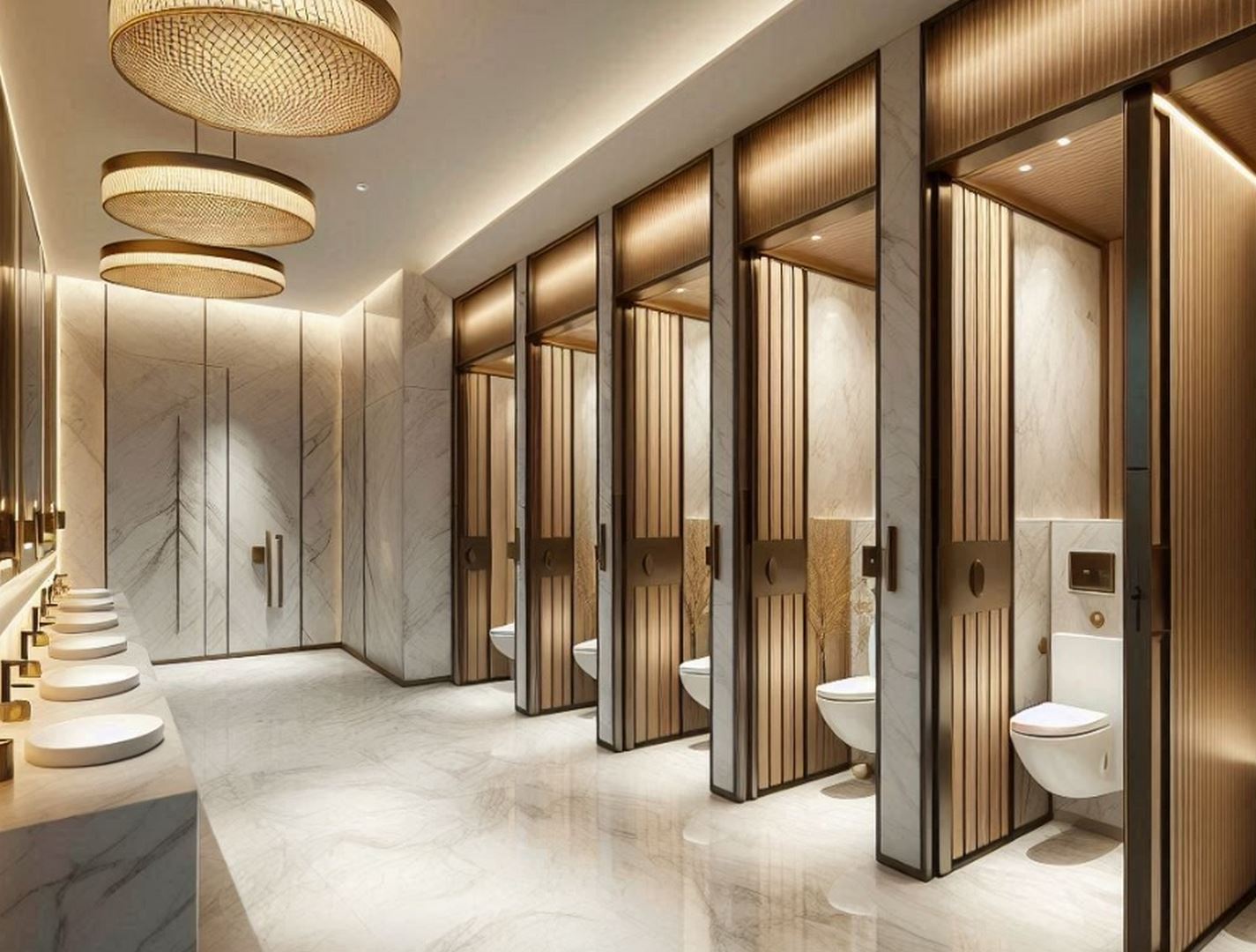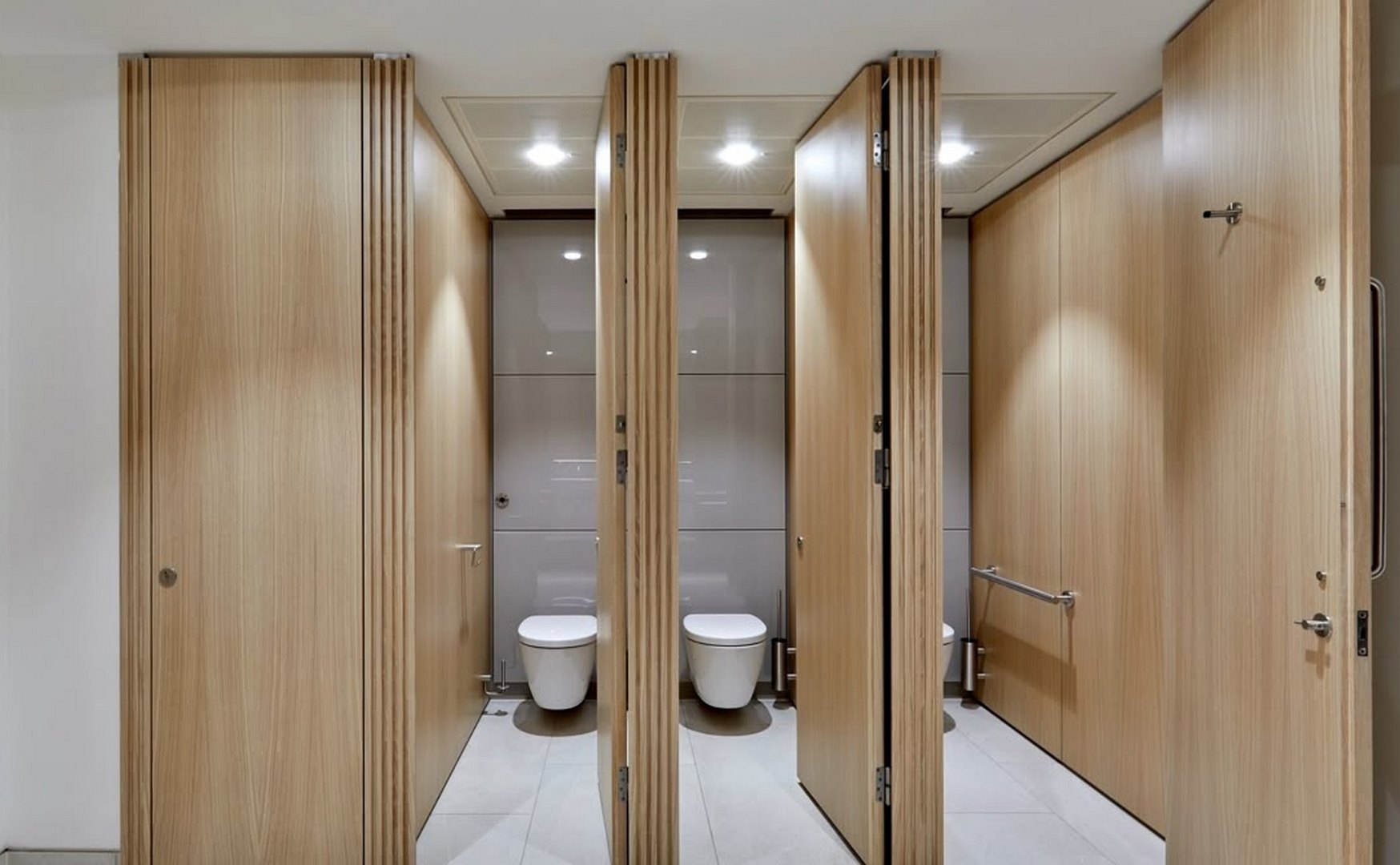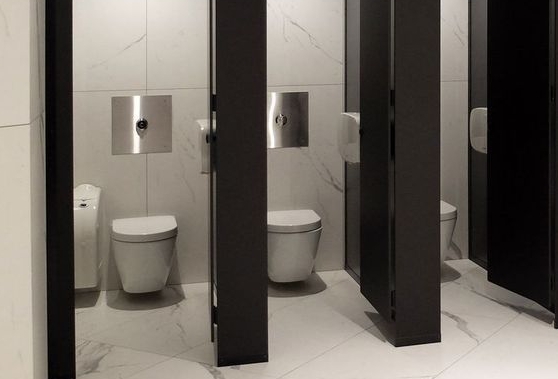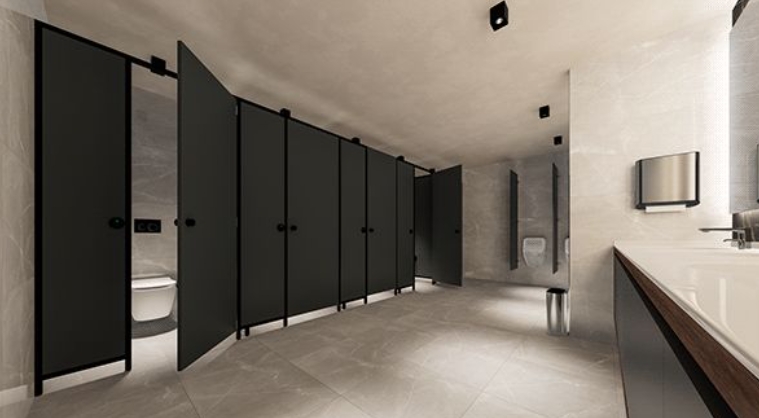When selecting a wall mount commercial toilet, various factors come into play that can greatly impact both functionality and user experience. From water efficiency and durability to design aesthetics and ADA compliance, each element requires careful consideration to guarantee you make an informed decision. The interplay between maintenance requirements and installation specifics further complicates the selection process. Not to mention, cost and warranty options can be pivotal in shaping your final choice. Understanding how these components work together is essential, but what truly sets the right toilet apart? The answer lies just ahead.

image from Pinterest
How does the water efficiency of a wall mount commercial toilet impact its overall performance and utility costs? The answer lies in the vital analysis of water consumption and advanced flushing technology. High-efficiency toilets (HETs) are engineered to minimize water usage without compromising performance. By adopting cutting-edge flushing technology, these units can achieve significant reductions in water consumption, ultimately leading to lower utility expenses.
Commercial settings demand systems that balance environmental factors with cost-effectiveness. wall mount toilets equipped with pressure-assisted flushing technology or dual-flush mechanisms are particularly advantageous. Pressure-assisted systems utilize compressed air to deliver a powerful flush with minimal water, typically around 1.1 to 1.6 gallons per flush (GPF), compared to traditional models that may use up to 3.5 GPF.
Dual-flush options provide users with the flexibility to choose between a lower volume flush for liquid waste and a higher volume for solid waste, further optimizing water usage.
When evaluating water efficiency, it is essential to reflect on the long-term savings associated with reduced water consumption. Selecting a toilet with advanced flushing technology not only enhances performance but also guarantees compliance with stringent environmental regulations, providing a sustainable solution for commercial applications.
When evaluating the durability of a wall mount commercial toilet, it is essential to conduct a thorough material quality assessment, focusing on the tensile strength and corrosion resistance of the materials used.
High-grade vitreous china or stainless steel are preferred for their resilience and minimal maintenance requirements, ensuring longevity in high-traffic environments.
Regular maintenance schedules should be established to address potential wear and tear, optimizing the toilet's operational lifespan and performance efficiency.
View our commercial toilet product catalog — all models are crafted from high-quality porcelain, offering exceptional durability for demanding commercial spaces.
Evaluating the material quality of a wall mount commercial toilet is essential for ensuring long-term durability and performance. A significant component of this assessment involves understanding the various ceramic types and their implications on structural integrity.
High-grade vitreous china is preferred for its superior resistance to chipping, scratching, and staining, which are vital in maintaining a pristine appearance over extended periods. It's important to confirm that the ceramic meets industry standards for density and composition, ensuring it can withstand the rigors of high-traffic environments without compromising functionality.
In addition to ceramic options, stainless steel presents an alternative material choice, particularly in environments demanding heightened vandal resistance and hygiene.
Stainless steel toilets are renowned for their robustness, corrosion resistance, and ease of cleaning. The alloy composition, typically 304 or 316, should be scrutinized to guarantee peak performance against environmental stressors and chemical exposure.
Selecting the appropriate material depends on the specific requirements of the commercial setting, such as anticipated usage frequency and maintenance capabilities.
Ensuring the longevity and ease of maintenance of a wall mount commercial toilet requires careful consideration of several critical factors. First and foremost, select toilets with surfaces that resist stains and wear, reducing cleaning frequency while enhancing aesthetic appeal. Consider vitreous china or stainless steel, which offer superior durability and resistance to harsh chemicals.
Additionally, toilets with a fully glazed trapway are less prone to blockages, thereby reducing maintenance interventions.
Prioritize models that offer streamlined repair accessibility. This includes selecting designs with easily removable panels or access points, ensuring that maintenance staff can quickly address any internal issues without extensive disassembly.
Opt for wall mount systems with modular components, allowing for swift replacement of parts, minimizing downtime, and preserving operational efficiency.
Furthermore, invest in fixtures with reliable flushing mechanisms, such as pressure-assist or dual-flush systems, which not only conserve water but also decrease wear on internal components, extending the toilet's lifespan.
Regular inspection schedules should be established to preemptively identify and rectify potential issues, thereby ensuring peak performance.

image from Pinterest
When evaluating design options for wall mount commercial toilets, it is essential to achieve a balance between aesthetic appeal and functional efficiency.
Space efficiency is a key consideration, especially in high-traffic areas, where ideal layout can enhance user flow and accessibility.
In addition, selecting the appropriate materials and finishes not only impacts durability and maintenance but also contributes to the overall visual harmony with the surrounding environment.
In the pursuit of achieving an aesthetic and functional balance in wall mount commercial toilets, it is essential to evaluate various design options that marry style with utility. The delicate intricacies of design harmony are fundamental in guaranteeing that the visual appeal of the restroom does not overshadow its operational efficacy.
Prioritizing user experience necessitates a keen attention to the interplay between the toilet's form and function.
First, consider the materials and finishes. Stainless steel and vitreous china offer robustness while complementing contemporary aesthetics. Integrating these materials can elevate the restroom's ambiance, aligning with corporate imagery and user expectations.
Additionally, the shape and contour of the toilet bowl can noticeably impact comfort and hygiene. Ergonomically designed seats are vital for enhancing user experience, while minimizing maintenance demands.
Furthermore, the flushing mechanism should not be overlooked. Options such as dual-flush systems provide both eco-friendly solutions and operational efficiency, catering to modern sustainability standards without compromising aesthetic integrity.
The cohesiveness of design elements should extend to flush plates and actuator buttons, which must mirror the overall architectural theme. By meticulously balancing these considerations, one can guarantee a seamless blend of aesthetic appeal with functional prowess in commercial restroom environments.
Achieve the perfect blend of form and function — explore our commercial toilet range designed to complement modern interiors while delivering reliable, high-performance utility.
Maximizing space efficiency in wall mount commercial toilets demands a thorough understanding of spatial dynamics and ergonomic principles. In environments where every square foot counts, ideal space utilization is vital. wall mount toilets inherently offer a streamlined profile, which enhances floor space availability and simplifies cleaning operations. This design choice reduces the footprint versus traditional floor-mounted counterparts, making them ideal for high-traffic facilities where user flow and maintenance ease are essential.
Design flexibility is also a significant consideration. The ability to adjust the height of wall mount units can cater to diverse user demographics, from accessibility compliance to catering to specific user groups. This adjustability is not merely a convenience but a strategic advantage in tailoring restroom facilities to specific needs and enhancing user experience.
Moreover, the integration of in-wall tank systems contributes to a sleek aesthetic while conserving space. Plumbing and mechanical systems must be meticulously planned to accommodate these concealed units, ensuring operational reliability.
This requires precise coordination with building infrastructure and adherence to building codes. By focusing on these aspects, facilities can achieve a harmonious balance between functionality and space efficiency, providing a high-quality restroom experience for all users.

image from Pinterest
Selecting appropriate materials and finishes for wall mount commercial toilets involves a thorough understanding of both functionality and aesthetics. The choice of material types is pivotal in ensuring durability and performance while maintaining an appealing visual presence. Common materials include vitreous china, stainless steel, and composite materials.
Vitreous china is renowned for its non-porous surface, offering excellent resistance to stains and easy maintenance. Stainless steel, on the other hand, is favored for its robustness and resistance to vandalism, making it ideal for high-traffic areas. Composite materials provide flexibility in design and can mimic the appearance of natural stone or ceramic.
In evaluating finish options, one must consider the environment and desired aesthetic. Glossy finishes, while visually striking, may require more frequent cleaning to maintain their luster. Matte finishes tend to hide fingerprints and water spots, making them suitable for areas with high usage.
Additionally, antimicrobial coatings are an advanced option, providing enhanced hygiene by inhibiting bacterial growth. Selecting the right combination of material types and finish options not only enhances the longevity and functionality of the toilet but also aligns with the overarching design theme, ensuring a seamless integration into the commercial space.
Guaranteeing ADA compliance is a critical consideration when selecting a wall mount commercial toilet, as it assures accessibility and inclusivity for all users. The Americans with Disabilities Act (ADA) provides essential guidelines that dictate the design and installation of commercial toilet facilities to accommodate individuals with disabilities.
Adhering to these ADA guidelines guarantees that your restroom facilities provide adequate accessibility features, such as appropriate height, clearance, and maneuvering space.
When choosing a wall mount toilet, verify that the fixture's rim height is within the ADA-specified range of 17 to 19 inches from the finished floor. This height facilitates ease of transfer from wheelchair to toilet, enhancing user independence.
Additionally, verify the toilet is installed with appropriate clearance for wheelchair access, typically requiring a minimum of 60 inches of turning space.
Moreover, water controls should be operable with one hand, without requiring tight grasping or twisting of the wrist, to cater to users with limited mobility. Opt for controls that require a maximum force of 5 pounds to operate.
When evaluating the maintenance needs of a wall mount commercial toilet, it is vital to take into account both the short-term and long-term care requirements. A thorough understanding of cleaning frequency is important, as this directly impacts operational efficiency and customer satisfaction. Generally, high-traffic environments necessitate more frequent cleaning schedules to maintain hygiene standards and minimize downtime.
Opting for materials that resist stains and bacteria can greatly reduce the cleaning frequency and associated labor costs.
Repair accessibility is another key factor to reflect on. wall mount toilets often house their plumbing and flushing mechanisms within the wall, which can complicate access during repairs. As a result, selecting models with easily removable panels or modular components can facilitate quicker troubleshooting and maintenance interventions.
This design feature allows maintenance personnel to efficiently address issues such as leaks or component failures without extensive wall modifications.
Additionally, weigh the availability of replacement parts when evaluating maintenance needs. Choosing models from reputable manufacturers with robust supply chains guarantees that parts are readily obtainable, minimizing potential disruption.
Analyzing the installation requirements of a wall mount commercial toilet is essential for ensuring a seamless integration into any facility. A thorough understanding of potential installation challenges and plumbing requirements is critical to achieving ideal functionality and compliance with industry standards.
To begin, assess the structural integrity of the existing wall. wall mount toilets necessitate robust support, typically requiring a reinforced wall or a carrier system capable of bearing the load, which can include additional costs and time for retrofitting.
Next, evaluate the plumbing requirements, focusing on the compatibility with existing water supply and waste lines. This involves ensuring the correct alignment and spacing, as deviations can lead to costly modifications.
The supply line must adhere to specific diameter and pressure standards to guarantee efficient flushing performance. Furthermore, consider the drain location and pipe slope, as these factors are pivotal for effective waste removal and to prevent drainage issues.
Comparing the cost and warranty options of wall mount commercial toilets requires a meticulous examination of several key factors. The objective is to guarantee that the investment aligns with the operational budget while providing adequate assurance against potential defects or failures.
A thorough cost comparison should consider not only the initial purchase price but also long-term maintenance and operational efficiencies.
Initial Cost Analysis: Break down the total expenditure, including unit price, installation costs, and any ancillary expenses.
Evaluate different models and manufacturers to identify cost-effective solutions without compromising quality.
Warranty Options Evaluation: Scrutinize the warranty terms provided by each manufacturer.
Standard warranties often cover manufacturing defects but vary in duration and coverage specifics. Assess if extended warranty options are available and their cost implications.
Lifecycle Cost Assessment: Beyond upfront costs, analyze the total cost of ownership (TCO) over the product's lifespan.
This includes maintenance requirements, expected durability, and any potential savings from water efficiency or reduced repair needs.

image from Pinterest
The average lifespan of a wall mount commercial toilet typically ranges from 10 to 15 years. Installation considerations and regular maintenance, such as inspecting seals and bolts, play an essential role in extending its durability and ensuring peak performance.
Can wall mount toilets withstand the rigors of high-traffic public restrooms? The answer hinges on critical installation considerations and diligent maintenance requirements. Properly installed, these toilets offer robust performance, but neglecting maintenance can undermine their reliability and efficiency in demanding environments.
When selecting the appropriate flushing mechanism, consider flushing technologies like gravity-fed versus pressure-assisted systems. Pressure-assisted systems provide robust performance, ideal for high-traffic environments, while gravity-fed systems offer quieter operation for low-traffic areas, ensuring efficient water usage and maintenance control.
Like a cornerstone in sustainable construction, selecting eco-friendly wall mount toilets involves considering sustainable materials such as recycled steel or ceramic. Installation considerations should include durability, maintenance, and compliance with industry standards to guarantee minimal environmental impact.
Wall-mounted toilets offer a space-saving design, optimizing floor area usage in confined spaces. Their aesthetic appeal enhances modern interiors, and the concealed cistern allows for streamlined maintenance, adhering to industry standards for efficiency and contemporary architectural preferences.
Selecting the right wall mount commercial toilet parallels a craftsman's choice of tools; precision and suitability are paramount. Consider the 20% reduction in water bills reported by a facility that prioritized water efficiency, demonstrating the long-term benefits of informed selection. Each criterion, from durability to ADA compliance, is a cog in a well-oiled machine, ensuring functionality and aesthetic coherence. A thorough evaluation is akin to crafting a masterpiece, balancing functionality, compliance, and cost for ideal restroom design.
Ready to make the right choice for your commercial restroom?
Explore our full range of wall mount commercial toilets — engineered for durability, efficiency, and modern design. Whether you're outfitting a high-traffic facility or upgrading an existing space, our high-quality porcelain toilets deliver long-lasting performance.
Browse our catalog or contact our team today for expert guidance.